No edit summary Tags: apiedit mobileedit |
Alucard10001 (talk | contribs) No edit summary Tag: sourceedit |
||
| Line 32: | Line 32: | ||
[[File:Tumblr m8nwu2EeHB1rt4vgvo1 1280.jpg|thumb|right|240px|Balrogs and a [[Fire-drake of Gondolin|fire worm]] before to attack the city of Gondolin by [[John Howe]]<ref>http://alan-and-john.tumblr.com/page/21</ref>]] |
[[File:Tumblr m8nwu2EeHB1rt4vgvo1 1280.jpg|thumb|right|240px|Balrogs and a [[Fire-drake of Gondolin|fire worm]] before to attack the city of Gondolin by [[John Howe]]<ref>http://alan-and-john.tumblr.com/page/21</ref>]] |
||
| − | During the [[First Age]], Balrogs were among the most feared of Morgoth's forces. When his [[fortress|Fortress]] of [[Utumno]] was destroyed by the [[Valar]], seven fled and lurked in the pits of [[Angband]]. If more existed before this time, they were slain by the Valar in Utumno. |
+ | During the [[First Age]], Balrogs were among the most feared of Morgoth's forces. When his [[fortress|Fortress]] of [[Utumno]] was destroyed by the [[Valar]], seven fled and lurked in the pits of [[Angband]]. If more existed before this time, they were slain by the Valar in Utumno. After Morgoth destroyed the [[Two Trees of Valinor]] with [[Ungoliant]], he came to the ruins of Angband to renew his rule in Middle-earth. But a disagreement with Ungoliant led to her attacking him, and Morgoth gave out a great cry that roused the Balrogs from their slumber. In what was described as a tempest of fire, the Balrogs drove Ungoliant away and prepared to pursue her. But they were checked by Morgoth and returned to Angband, which shortly thereafter was constructed anew. |
| + | |||
| + | The Balrogs were first encountered by the [[Elves]] during the [[Dagor-nuin-Giliath]] (Battle-under-Stars) in the First Age. After the great victory of the [[Ñoldor]] over Morgoth's [[orc]]s, [[Fëanor]] pressed on towards [[Angband]] with only a small vanguard. Seeing this, the Orcs fled to the gates of Angband, where a number of Balrogs came against the Elves. Fëanor fought long, but was at last mortally wounded by Gothmog, Lord of Balrogs. Fëanor's sons soon arrived with reinforcements, and the Balrogs and Orcs returned to Angband, but [[Fëanor]] died of his wounds soon after, and his spirit departed for the [[Halls of Mandos]]. Shortly there after, Morgoth sent a message to the Elves indicating that he was considering parley, and even offering to surrender one of the [[Silmaril]]s that he had stolen. [[Maedhros]], the leader of the Noldor in Middle-earth at the time, suspected treachery, and sent a larger force than agreed upon. But Morgoth's forces were also greater than he had promised, and with them were Balrogs. As such, the entire Elven company was slain save Maedhros, who was captured but later rescued. The next venture of the Balrogs into the field was during [[Dagor Bragollach]], where they helped to rout the Elven and [[Edain]] armies. They were also present at the Battle of Unnumbered Tears (Nirnaeth Arnoediad). Gothmog, High Captain of Angband, led the invasion. He threw aside [[Hurin]] and [[Turgon]], turned upon [[Fingon]] and killed him with the help of another Balrog, securing the field for Morgoth's forces. He also captured Hurin after Hurin was buried under a mountain of slain foes. He bound the human warrior and delivered him to Angband, whereupon Morgoth attempted unsuccessfully to pry the location of [[Gondolin]] from him. During the [[Fall of Gondolin]], [[Ecthelion]] managed to kill Gothmog at the cost of his own life. Another Balrog confronted Tuor and those attempting to escape the siege. [[Glorfindel of Gondolin|Glorfindel]] fought the Balrog to give his friends a chance to escape. The battle ended with Glorfindel casting down the Balrog from the mountain but being pulled down along with the demon. The last Balrogs fought in the [[War of Wrath]] but were either slain or forced to retreat. |
||
[[File:Xtra09.jpg|thumb|left|240px|The portrait in [[Saruman]]'s book at [[Orthanc]] of Durin's Bane.]] |
[[File:Xtra09.jpg|thumb|left|240px|The portrait in [[Saruman]]'s book at [[Orthanc]] of Durin's Bane.]] |
||
| − | Most of the Balrogs of [[Morgoth]] were destroyed during the [[War of Wrath]] at the end of the [[First Age]], but some few "fled and hid themselves in caverns inaccessible at the roots of the earth."<ref name="SimWar">''[[The Silmarillion]], [[Quenta Silmarillion]],'' Chapter XXIV: "[[Of the Voyage of Eärendil and the War of Wrath]]"</ref> During the [[Third Age]], it was discovered that one of these had hidden deep beneath the [[Misty Mountains]], near Moria. That was [[Durin's Bane]], the best-documented of the Balrogs. The [[Dwarves]] of [[Khazad-dum|Khazad-dûm]] had accidentally awakened it while greedily mining too deep for [[Mithril]]. It was Durin's Bane that drove the dwarves from their homeland in Moria. Later, in his confrontation with the wizard Gandalf and the the [[Fellowship of the Ring]], he pursued them to the bridge of Khazad-dûm. Gandalf fought the Balrog allowing the Fellowship to escape Moria.<ref>''[[The Lord of the Rings]], [[The Fellowship of the Ring (novel)|The Fellowship of the Ring]],'' Book Two, Chapter V: "The Bridge of Khazad-dûm"</ref> Both were slain, but [[Gandalf]] was "sent back" by the Valar (or possibly by Iluvatar).<ref>''[[The Two Towers (novel)|The Lord of the Rings, The Two Towers]],'' Book Three, Chapter V: "The White Rider"</ref> |
+ | Most of the Balrogs of [[Morgoth]] were destroyed during the [[War of Wrath]] at the end of the [[First Age]], but some few "fled and hid themselves in caverns inaccessible at the roots of the earth."<ref name="SimWar">''[[The Silmarillion]], [[Quenta Silmarillion]],'' Chapter XXIV: "[[Of the Voyage of Eärendil and the War of Wrath]]"</ref> During the [[Third Age]], it was discovered that one of these had hidden deep beneath the [[Misty Mountains]], near Moria. That was [[Durin's Bane]], the best-documented of the Balrogs save Gothmog. The [[Dwarves]] of [[Khazad-dum|Khazad-dûm]] had accidentally awakened it while greedily mining too deep for [[Mithril]]. It was Durin's Bane that drove the dwarves from their homeland in Moria. Later, in his confrontation with the wizard Gandalf and the the [[Fellowship of the Ring]], he pursued them to the bridge of Khazad-dûm. Gandalf fought the Balrog allowing the Fellowship to escape Moria.<ref>''[[The Lord of the Rings]], [[The Fellowship of the Ring (novel)|The Fellowship of the Ring]],'' Book Two, Chapter V: "The Bridge of Khazad-dûm"</ref> Both were slain, but [[Gandalf]] was "sent back" by the Valar (or possibly by Iluvatar).<ref>''[[The Two Towers (novel)|The Lord of the Rings, The Two Towers]],'' Book Three, Chapter V: "The White Rider"</ref> |
==Appearance== |
==Appearance== |
||
| Line 189: | Line 191: | ||
[[he:באלרוגים]] |
[[he:באלרוגים]] |
||
| + | |||
| ⚫ | |||
| ⚫ | |||
| ⚫ | |||
| ⚫ | |||
| ⚫ | |||
| ⚫ | |||
[[Category:Sindarin words]] |
[[Category:Sindarin words]] |
||
[[Category:Maiar]] |
[[Category:Maiar]] |
||
| Line 198: | Line 207: | ||
[[Category:Games Workshop Character]] |
[[Category:Games Workshop Character]] |
||
[[Category:Evil]] |
[[Category:Evil]] |
||
| − | |||
| ⚫ | |||
| ⚫ | |||
| ⚫ | |||
| ⚫ | |||
| ⚫ | |||
| ⚫ | |||
[[Category:Villains]] |
[[Category:Villains]] |
||
[[Category:Servants of Darkness]] |
[[Category:Servants of Darkness]] |
||
Revision as of 10:32, 25 January 2016
- "Then something came into the chamber - I felt it through the door, and the orcs themselves were afraid and fell silent. It laid hold of the iron ring, and then it perceived me and my spell."
- —The Lord of the Rings, "The Bridge of Khazad-dûm"
Balrogs were the Valaraukar (Quenya; vala "power" + rauko "monster"), spirits of the Maiar that were seduced and corrupted by Melkor to his service.[1] There were never more than seven, according to Tolkien's son, but in earlier versions of Tolkien's writings there are references to entire armies of Balrogs, at least before the destruction of Utumno. Gothmog was their captain during the First Age.
Origins
Balrogs were "scourges of fire, ... demons of terror."[1] They were Maiar, originally of the same order as Saruman and Gandalf, but they were seduced by Melkor, who corrupted them to his service in the days of his splendour before the creation of Arda. During the Music of the Ainur, the Ainulindalë, Melkor (Morgoth) began introducing themes of his own design into the Theme of Ilúvatar, causing great discord in the music. Balrogs were among those spirits near Melkor who attuned their own music to Melkor's theme rather than Ilúvatar's. Therefore, they not only existed before the creation of the world, they also had a part in its corruption.
History
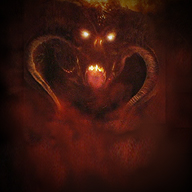
Fallen flame of Udûn
Balrogs and a fire worm before to attack the city of Gondolin by John Howe[2]
During the First Age, Balrogs were among the most feared of Morgoth's forces. When his Fortress of Utumno was destroyed by the Valar, seven fled and lurked in the pits of Angband. If more existed before this time, they were slain by the Valar in Utumno. After Morgoth destroyed the Two Trees of Valinor with Ungoliant, he came to the ruins of Angband to renew his rule in Middle-earth. But a disagreement with Ungoliant led to her attacking him, and Morgoth gave out a great cry that roused the Balrogs from their slumber. In what was described as a tempest of fire, the Balrogs drove Ungoliant away and prepared to pursue her. But they were checked by Morgoth and returned to Angband, which shortly thereafter was constructed anew.
The Balrogs were first encountered by the Elves during the Dagor-nuin-Giliath (Battle-under-Stars) in the First Age. After the great victory of the Ñoldor over Morgoth's orcs, Fëanor pressed on towards Angband with only a small vanguard. Seeing this, the Orcs fled to the gates of Angband, where a number of Balrogs came against the Elves. Fëanor fought long, but was at last mortally wounded by Gothmog, Lord of Balrogs. Fëanor's sons soon arrived with reinforcements, and the Balrogs and Orcs returned to Angband, but Fëanor died of his wounds soon after, and his spirit departed for the Halls of Mandos. Shortly there after, Morgoth sent a message to the Elves indicating that he was considering parley, and even offering to surrender one of the Silmarils that he had stolen. Maedhros, the leader of the Noldor in Middle-earth at the time, suspected treachery, and sent a larger force than agreed upon. But Morgoth's forces were also greater than he had promised, and with them were Balrogs. As such, the entire Elven company was slain save Maedhros, who was captured but later rescued. The next venture of the Balrogs into the field was during Dagor Bragollach, where they helped to rout the Elven and Edain armies. They were also present at the Battle of Unnumbered Tears (Nirnaeth Arnoediad). Gothmog, High Captain of Angband, led the invasion. He threw aside Hurin and Turgon, turned upon Fingon and killed him with the help of another Balrog, securing the field for Morgoth's forces. He also captured Hurin after Hurin was buried under a mountain of slain foes. He bound the human warrior and delivered him to Angband, whereupon Morgoth attempted unsuccessfully to pry the location of Gondolin from him. During the Fall of Gondolin, Ecthelion managed to kill Gothmog at the cost of his own life. Another Balrog confronted Tuor and those attempting to escape the siege. Glorfindel fought the Balrog to give his friends a chance to escape. The battle ended with Glorfindel casting down the Balrog from the mountain but being pulled down along with the demon. The last Balrogs fought in the War of Wrath but were either slain or forced to retreat.
Most of the Balrogs of Morgoth were destroyed during the War of Wrath at the end of the First Age, but some few "fled and hid themselves in caverns inaccessible at the roots of the earth."[3] During the Third Age, it was discovered that one of these had hidden deep beneath the Misty Mountains, near Moria. That was Durin's Bane, the best-documented of the Balrogs save Gothmog. The Dwarves of Khazad-dûm had accidentally awakened it while greedily mining too deep for Mithril. It was Durin's Bane that drove the dwarves from their homeland in Moria. Later, in his confrontation with the wizard Gandalf and the the Fellowship of the Ring, he pursued them to the bridge of Khazad-dûm. Gandalf fought the Balrog allowing the Fellowship to escape Moria.[4] Both were slain, but Gandalf was "sent back" by the Valar (or possibly by Iluvatar).[5]
Appearance
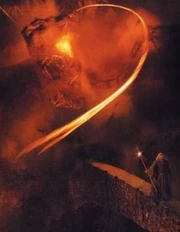
The Balrog's Whip.
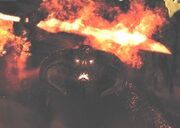
Utilizing Udun's flame in shape of a fiery sword.

The sword of hell in detail by G17RDY Creations and Hecubus114
A Balrog generally took the form of a tall, menacing being roughly in the shape of a Man, having control of both fire and shadow and wielding a fiery whip with several thongs (Gothmog, the Lord of Balrogs in the First Age, used an axe as well). They induced great terror in friends and foes alike. Many who faced Balrogs referred to them as "creatures of fire and shadow" or simply "shadow and flame."
In his published works, Tolkien depicts the Balrog as being barely a shape wreathed in shadow and flame - possibly man-shape, yet greater. Balrogs seemed to encapsulate and project power and terror.
Additionally, they may have been able to alter their body structures on occasion, as in the battle between Durin's Bane and Gandalf, when the Balrog fell into a body of water he shifted himself into something gelatinous. However, it is also possible that this alternate form was simply Gandalf using colorful language to describe what the Balrog was like after having its flame extinguished and being covered in water.
In the film adaptations, the head somewhat resembles a skull with ram's horns, while being itself wrapped in its flames. Obviously quite a bit of creative license was used, as nowhere in Tolkien literature is the Balrog described in this way, and is much larger than Tolkien ever described. Tolkien described the Balrog being only "several feet taller than an average man" but in Peter Jackson's film adaptation the Balrog towers over everything.
Capabilities
Balrogs were phenomenally powerful creatures. They were amongst the most trusted and oldest servants of Morgoth, and, with dragons, were the most powerful creatures under Morgoth's command. In Tolkien's later writings, he made note of the fact that there could not have ever been more than seven Balrogs, yet they were able to drive away Ungoliant in what was described as a "tempest of fire". This is all the more impressive considering that even Tulkas was helpless before the Unlight that Ungoliant spewed to cover her escape.
Balrogs' most renowned and feared magics involved the creation or summoning of fiery weapons. In addition, these fallen Maia could ignite and engulf themselves in flames.
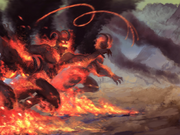
Haste of the Balrogs by Viking-Heart
The extent of their command of magics other than their weaponry is something of a mystery. It is known however, that they possess the ability to cast spells in a similar manner to the Istar, Durin's Bane was able to cast a counter-spell against Gandalf so potent that it overwhelmed a spell he had been using to keep a door closed.
It seems likely that they cannot be hurt with normal weapons as Gandalf said. Gandalf could fight against the demon because Gandalf himself is a Maia as well and the blade used by him was Glamdring, a sword of Gondolin. They were gifted with near-incalculable physical strength, speed, durability and stamina, and were tremendously difficult to kill - even after quenching the fire of Durin's Bane, Gandalf was forced to spend several days battling the Balrog.

Gothmog, the original Lord of Balrogs
Miscellaneous
In one of Tolkien's pre-Middle-earth stories, Lay of the Children of Húrin, "Lungothrin, Lord of Balrogs," is mentioned. It is not certain whether this was another name for Gothmog, or whether it simply meant "a Balrog lord." According to Christopher Tolkien, the latter is more probable, as the name Gothmog was mentioned in the earliest Middle-earth writings, as well as in the final versions of Tolkien's mythology.
The early conception of Balrogs makes them less terrible, and certainly more destructible, than they afterwards became: they existed in 'hundreds' (p. 170), and were slain by Tuor and the Gondothlim in large numbers: "thus five fell before Tuor's great axe Dramborleg, three before Ecthelion's sword, and two score were slain by the warriors of the king's house." —The Book of Lost Tales 2, commentary by Christopher Tolkien on The Fall of Gondolin.
"There came wolves and serpents and there came Balrogs one thousand, and there came Glomund the Father of Dragons." The Lost Road, Chapter 16. (Glomund's name became Glaurung when Tolkien wrote the Silmarillion.
Durin's Bane, the Balrog of Moria, one of the last of its kind
When Tolkien developed Middle-earth as the backdrop for The Lord of the Rings, Balrogs became more formidable and terrible, and their number was much reduced. In the end Christopher Tolkien stated that there were "at most" seven Balrogs:
- "In the margin my father wrote: 'There should not be supposed more than say 3 or at most 7 ever existed.'"
- —Morgoth's Ring, Section 2 (AAm*): Note 50
And yet, in The Silmarillion, which is considered canon, Tolkien wrote that during meant that those "few that fled and hid themselves" numbered only three or at most seven.
Known Individuals
All the known Balrogs were seemingly males. It is even unknown there were even genders among them.
- Gothmog - the first Balrog to wield the title of the Lord of Balrogs (presumably the title was indeed created for him)
- Lungothrin - also claiming the title of the Lord of Balrogs and was the vital chief for guards of Angband with his piety to the Dark Lord rivaling that of Gothmog
- Durin's Bane - the only known individual to have survived the War of Wrath, and also unique in being the only Balrog not to be affirmatively tied-up with the dark forces of his time.
Portrayal in adaptations
Video games
- In the video games The Lord of the Rings: The Battle for Middle-earth and The Lord of the Rings: The Battle for Middle-earth II, the Balrog is a power of the goblins and Mordor which cost 25 Power points, with Whip, Sword, Wings, Firebreath and other weapons can cause devastating damage towards enemy units and structures.
- It is also a Boss character in The Lord of the Rings: The Fellowship of the Ring Video Game, The Lord of the Rings: The Two Towers on Game Boy Advance and The Lord of the Rings: The Third Age. In the latter, the Balrog is fought by Gandalf on the Player's side and becomes a usable hero for the duration of the battle. Though it is referenced in the video games based on the Films.
- It also appears in The Lord of the Rings: Aragorn's Quest, resembling the movie version.
- Two Balrogs also appear in The Lord of the Rings Online: Thaurlach, located deep within the Rift of Nurz Ghashu in Angmar, and Durin's Bane, encountered several times during introductive "quests" to Moria. An illusion of Durin's Bane is encountered in the Ost Dunhoth Instance Raid.
- In LEGO The Lord of the Rings: The Video Game, players can play as Gandalf and fight with, and eventually defeat the Balrog.
- The Balrog is also a playable Hero in The Lord of the Rings: Conquest in Mission 4 - The Mines of Moria and Mission 7- The Shire (Evil Campaign)
Card games
- Balrog (named Firelord Balrog) appears in the game The Legend of the Cryptids as a playable card.
Portrayal in Adaptations
Translations around the World
| Foreign Language | Translated name |
|---|---|
| Chinese (Hong Kong) | 炎魔 |
| Russian | Балроги |
Etymology
The Quenya form is Valarauko or Valarauco (IPA: [valaˈraʊko]), and the plural is Valaraukar or Valaraucar ([valaˈraʊkar]). The Sindarin form was "Demon of Might"; IPA: [ˈbalroɡ]; Sindarin plural Belryg; [ˈbelryɡ] or later [ˈbelriɡ])
Gallery
New Line Films
Arts
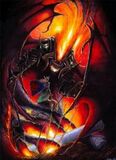 |
 |
 |
 |
 |
 |
 |
 |
 |
 |
In Other Medias
 |
 |
 |
Trivia
- Almost all the known individuals were vanquished in terms of double suicides or falling together. All the Balrogs within their final battles end in falling. Gothmog sunk deep in the fountain, Glorfindel's Balrog fell over a cliff, and Durin's Bane actually fell twice (Fell with Gandalf from the Bridge of Khazad-dûm and thrown down from the top of Zirakzigil by the final blow of the wizard)
- Seemingly, there had not been dangerous conflicts between Balrogs and Dragons. It is unclear this was achieved because these fiery demons and monsters were indeed compatible and were sensible, or there were none community of interests, and both of them were unconcerned about each other. Or such situations might have been restricted and controlled by orders of their master to evade damaging by most mighty members to his own forces.
- Some fans of the Doom series claim that the Balrog of the movies looks similar to a cross between a D3 Cyberdemon and a D3 Maledict (Cyberdemon with Maledict Wings).
- A demonic monster in the popular 2D side-scrolling game Maplestory, bears many similar qualities and characteristics, and thus many believe the monster was represented on behalf of the fictitious one depicted in the Tolkien series.
- A certain red-skinned antagonist in the MMO-RPG Wartune is identical exactly to a Balrog but for his 4 black horns.
- A demon in Dungeon Hunter: Alliance called the "Cremator "has the same head and fiery presence as a Balrog, without wings.
- A demonic monster in another popular 3D game is called "Mabinogi."
- Many fans claim that the Balrog inspired Games Workshop's Bloodthirster in Warhammer, which is known as the Greater Daemon of Khorne (the Chaos God of Blood, Battle, War and Rage.)
- The main antagonist of Prince of Persia: Warrior Within, the Dahaka, strongly resembles the Balrog, but has one horn bent downward, and it does NOT have wings.
- The Balor from Dungeons and Dragons is clearly based on the Balrog.
- In early editions of the game, it was actually referred to as the Balrog. The name was changed due to copyright claims made by Tolkien Estate.
- The hero named Hellbringer from Heroes of Newerth (A game that is based on a popular Warcraft III mod known as Defense of the Ancients.) can summon Malphas which is clearly based on the Balrogs.
- War, the first horseman and main playable character from the game Darksiders has a chaos form that looks very similar to Durin's Bane.
- Balrog was the name of a boxer from USA who made his debut as the second boss in Street Fighter II. Although he cannot kick, he made up for it with pummeling punches. This name was originally part of a triangle of replacement; the original Japanese game credited him as M. Bison (after boxer Mike Tyson), leaving the character Vega named Balrog.
- In the manga and anime series Saint Seiya, Balrog Rune (or Balron Lune) is a servant of Hades clad in armor modeled after Tolkien's monster.
- The Juggernaut and its upgrade the Ravager in Heroes VI, also resembles the Balrog's looks, especially the head region. Whether this is on purpose or just a coincidence is not known.
- The boss Fyrus from Legend of Zelda: Twilight Princess, bears a slight resemblance to Balrog, in it's height and black fiery form.
- The form for the character Chaos in Dissidia 012 Final Fantasy, Feral Chaos ("Desperado Chaos" in the Japanese version), bore a strong resemblance to the Balrog (particularly its depiction in the Peter Jackson films) due to his being massive, demonic, possessing horns, and constantly wreathed in flames.
In Dota 2, Clinkz bears a striking resemblance to a Balrog portrayed in the Lord of the Rings movies, with horns and flames. In addition, Clinkz's "death" ends up in a sort of double suicide, with the monster the was facing dying at the same time he was.
| This page uses content from Wikipedia. The original article was at Balrog. The list of authors can be seen in the page history. As with The One Wiki to Rule Them All, the text of Wikipedia is available under the Commons Attribution-Share Alike license. |
References
- ↑ 1.0 1.1 The Silmarillion, Valaquenta: "Of the Maiar"
- ↑ http://alan-and-john.tumblr.com/page/21
- ↑ The Silmarillion, Quenta Silmarillion, Chapter XXIV: "Of the Voyage of Eärendil and the War of Wrath"
- ↑ The Lord of the Rings, The Fellowship of the Ring, Book Two, Chapter V: "The Bridge of Khazad-dûm"
- ↑ The Lord of the Rings, The Two Towers, Book Three, Chapter V: "The White Rider"
External links
 Balrogs at Tolkien Gateway
Balrogs at Tolkien Gateway- The Truth About Balrogs essay series by Conrad Dunkerson.

